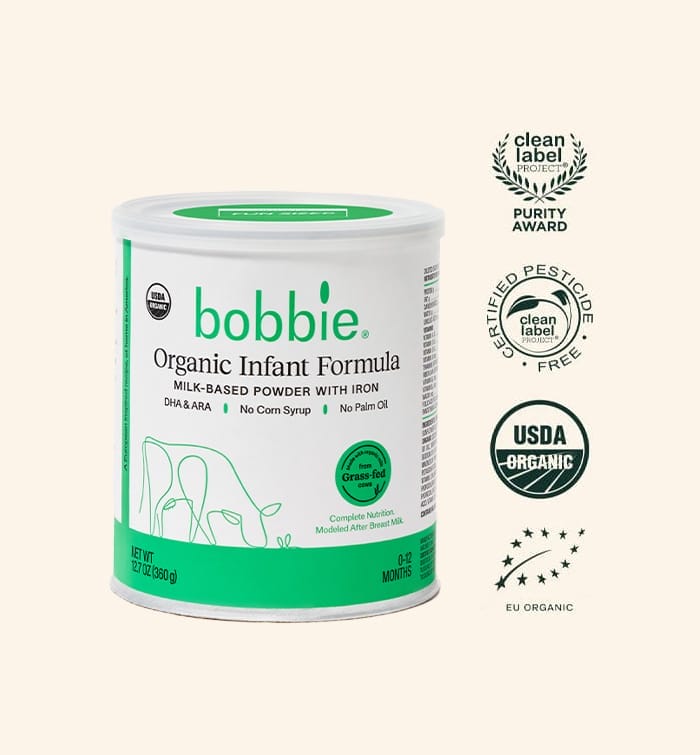We are proud to say that these posts are not sponsored. Our editorial team of Bobbie moms and writers personally select each featured product. If you buy something through our links, we may earn an affiliate commission, at no cost to you.
So much is out of your control when you’re pregnant, from the level of nausea you experience not only in the morning hours (thanks pregnancy hormones!) to the amount of poking and prodding you have to go through during your prenatal visits. So it only makes sense that you’d feel a desire to control some aspect surrounding your birth, like getting the party started by inducing your own labor, especially after what probably feels like two years of pregnancy. The ways to induce labor vary, so we asked expert Jane Van Dis, M.D., board-certified OBGYN and Bobbie medical advisor how exactly to induce labor.
- Inducing labor
- How to induce labor at home
- Natural ways to induce labor
- Exercises to induce labor
- Does sex induce labor?
- Apply evening primrose oil to induce labor
- Eating spicy foods or other foods that induce labor
- Castor oil to induce labor
- Why would a woman be medically induced?
- Guaranteed ways to induce labor
- Medicine to induce labor

Shop Bobbie Organic Infant Formula
Bobbie Organic Infant Formula is a USDA Organic, EU-style infant formula that meets all FDA requirements. It is a complete nutrition milk-based powder modeled after breast milk and is easy on tummies. It is non-GMO and doesn't have corn syrup, palm oil, or maltodextrin. Learn more about Bobbie.
What is labor during pregnancy?
“Labor is one of those bodily occurrences that tends to happen on its own. It happens most often between weeks 37 and 42 when regular uterine contractions become more frequent and close together, causing your cervix to both thin out, known as effacement, and dilate, which means open,” explains Van Dis.
Labor is divided into three phases: early labor, active labor and transitional labor. Early labor, when the cervix dilates to 4 to 6 centimeters and you experience contractions 5-20 minutes apart, is usually the longest part. “It can last for days or even weeks,” Van Dis says. Active labor is usually a lot more intense, not to mention painful. In this phase, the cervix can be dilated anywhere from 4 to 8 centimeters and your contractions are happening every minute to minute and a half. The last phase of labor is known as “transitional labor.” It’s during this phase that you actually give birth, which is why it’s usually the shortest of the three.
Inducing labor
For most women in America, the majority of the labor process occurs at a hospital or birthing center, per research published by the National Academies of Sciences, Engineering, and Medicine, but many women try to labor at home for as long as they can. And there are plenty of reasons why this might be a good idea, so long as your pregnancy is not high risk. For starters, labor can take a long time, as previously mentioned, so you might be more comfortable spending upwards of 20 hours in the comfort of your home rather than on a hospital bed. Some hospitals also won’t admit you unless you’re at least 4 centimeters dilated and your contractions are as little as 4 minutes apart.
How to induce labor at home
“A woman wouldn’t want to induce labor at home,” shares Van Dis, “ unless she’s past 39 weeks and 0 days. After that point, she should have a discussion with her physician or midwife about inducing labor at home, because these terms, “labor induction” might mean different things for patients and health care providers.”
Natural ways to induce labor
“If there were a magic potion, spell or activity that would put all women still pregnant after 39 weeks into labor – believe me – your midwife or physician would be recommending it to all women 39 weeks or greater,” exclaims Van Dis. “Unfortunately there isn’t a solution that will inevitably lead to labor and studies have been done regarding some of the wives’ tales – like sex or jalepeños or exercise or nipple stimulation— none have been shown to increase the likelihood of labor, though friends or relatives may swear by one method or another.”
If you’re eager to get your labor started, here are some mom-approved tactics that might just do the trick to induce labor naturally:
Exercises to induce labor
If moderate exercise is a part of your pregnancy routine, good for you, Mama! The American College of Obstetricians and Gynecologists recommend that pregnant women get at least 150 minutes of moderate-intensity exercise each week, which averages out to 30 minutes five days a week. What’s more— walking towards the end of your pregnancy may just be what encourages your baby to move on downwards. The old wive’s tale is that the pressure pushes your baby’s head down on your pelvis, readying your cervix for labor—and there just might be some truth to it. In fact, one 2022 study published in the Journal of Maternal-Fetal and Neonatal Medicine found that walking 40 minutes four times a week past the 34th week of pregnancy improved Bishop score, a measurement that indicates how close a woman is to labor.
Does sex induce labor?
Sex might be the furthest thing from your mind when you feel 100 months pregnant, but old wives’ tales have it that doing the deed might get the labor party started a little earlier. While there’s no scientific proof that having sex will put you into labor sooner than your body is ready, research does support its benefits towards the end of pregnancy. One study published in the journal Obstetrics & Gynecology found that women who had sex at term (40 weeks pregnant) delivered their babies sooner than those who were not sexually active. Another study published in The Iranian Red Crescent Medical Journal linked younger gestational age of babies born to women who reported being sexually active prior to delivery. Bottom line: So long as your pregnancy is low risk and you’ve gotten your doctor’s okay, sex at any point of your pregnancy, especially towards the end, can only help.
Apply evening primrose oil to induce labor
There are plenty of herbal supplements out there that are hailed for all sorts of things. One is evening primrose oil, which has been widely been thought to help induce labor naturally. While the jury is out as to whether or not the concept of applying evening primrose oil to your lady bits can expedite anything related to your labor and delivery, research published in the journal American Family Physician, has pointed to the supplement’s potential to soften and thin out the cervix. Another study by the same medical journal found that evening primrose oil could help shorten labor. While there’s no proof that evening primrose oil can help induce your labor, if your doctor gives you the thumbs up, why not?
Eating spicy foods or other foods that induce labor
This one you’ve probably heard before— some people believe that eating spicy foods revs up your engines, so to speak, and encourages labor. Unfortunately there’s no data to support this, and, unfortunately, eating spicy, especially acidic, foods towards the end of your pregnancy may only leave you with heartburn. If you’re already eating spicy foods on the regular, however, and they’re not causing you discomfort, fork up, Mama!
Castor oil to induce labor
This one probably sounds the least appetizing, but it has been passed down between childbearing women for generations. Legend has it that ingesting a small amount of this common ingredient found in soaps, lubricants and other household products can encourage uterine contractions and stimulate labor. There’s very little data to support this, but there are a few studies. One study published in The Journal of Maternal-Fetal & Neonatal Medicine linked using castor oil to a higher probability of labor while another small study, published in the journal Alternative Therapies in Health and Medicine, found that close to 60 percent of women who ingested 60 milliliters (just over a shot-glass worth) of castor oil went into labor within a 24-hour period.
Why would a woman be medically induced?
Van Dis says there are many common reasons to medically induced, which could include:
A pregnancy past 41 weeks 0 days
A history of hypertensive disease in pregnancy
Multiple gestation
Diabetes in pregnancy
Low fluid
Growth restriction of the fetus
Non-reassuring fetal status on electronic fetal heart rate monitoring
Guaranteed ways to induce labor
“There are a few methods to medically induce labor and they include 2 phases of induction,” says Van Dis:
1) Preparing the cervix for labor by softening the cervix
2) Provoking uterine contractions to help the baby deliver.
Medicine to induce labor
“Prostaglandins (a natural occurring hormone) can help to soften the cervix and can be ingested orally, allowed to dissolve in your cheek, or inserted into your vagina,” says Van DIs. “Alongside this type of medication, some physicians or midwives might also recommend a balloon be placed to help the cervix soften. After the cervix is soft and slightly dilated, Pitocin (a synthetic form of oxytocin— the hormone produced in your pituitary) is commonly given to help the uterus contract. In summary, prostaglandins, a balloon and an IV medication are the most common ways that women are medically induced.”

Shop Bobbie Organic Infant Formula
Bobbie Organic Infant Formula is a USDA Organic, EU-style infant formula that meets all FDA requirements. It is a complete nutrition milk-based powder modeled after breast milk and is easy on tummies. It is non-GMO and doesn't have corn syrup, palm oil, or maltodextrin. Learn more about Bobbie.

